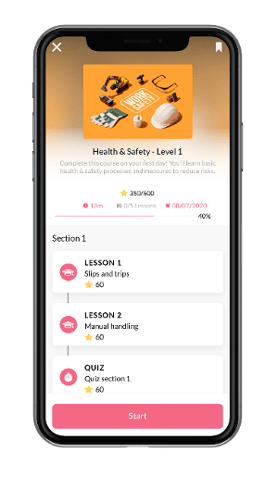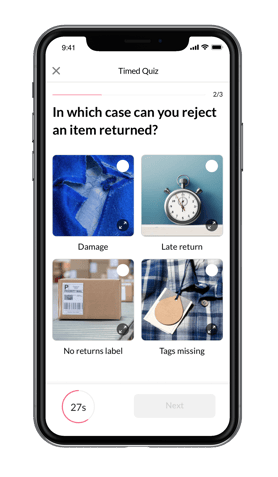What if there was a way to train your workforce so they quickly master and apply knowledge, wherever they are and whatever their role?
Well there is, and it’s called microlearning.
Microlearning isn’t a new concept by any means. The term was first coined in the 60s, but it’s only been over the last few years that it’s taken the learning industry by storm.
Microlearning isn’t just a buzzword. The size of the global microlearning industry is expected to grow to $2.7 billion USD by 2024.
But what is microlearning exactly, and what makes it the best choice for onboarding, training and continuous learning, especially when employees are geographically dispersed?
Table of Contents:
1. What is Microlearning?
2. Why Use Microlearning to Train Employees?
3. How to Create Microlearning Content
4. How to Deliver Microlearning
5. Other Things to Consider
What is Microlearning?
Microlearning is a skills-based approach to learning where content is delivered in short chunks, bites or nuggets that learners access whenever they need to, usually on a mobile device.
Each microlearning session is about one self-contained, standalone topic.
What’s the goal of microlearning?
To help learners quickly master, apply and retain knowledge around a very specific topic.
Alternately, the goal of traditional learning approaches is merely the presentation of information.
The goal of microlearning isn’t just to make training content shorter so it takes up less of learners’ time.
It’s to quickly integrate information into a learner’s working memory, so it can be applied correctly in real life.
Microlearning does all of the following:
- Reduces cognitive load on learners
- Presents content in interactive formats that engage the user
- Focuses each short session on one applicable piece of information rather than a broader concept
- Encourages learners to engage on a deeper level with content
- Fits well with a large variety of learning styles
What are some examples of microlearning?
| Microlearning ✅ |
Not Microlearning ❌ |
| Reading a short paragraph about a hypothetical situation where a customer tries to return an item, then selecting the best response from multiple choice items below |
Watching a 10 minute video about a retailer’s return policy. |
| Watching a 3 minute video covering the basics of a new sanitation protocol and completing a 3 question quiz afterwards. |
Reading a mobile-friendly infographic about a new warehouse sanitation protocol. |
Microlearning is about absorbing new information and successfully applying it.
Is microlearning the same thing as mobile learning?
Not quite.
Mobile learning is training that’s completed on a tablet or smartphone, wherever and whenever convenient for the learner. Mobile learning is optimized for whatever device the learner is using.
Microlearning is about the learning content itself - both its objective and structure.
We can think of mobile learning as the delivery mechanism, and we can think of microlearning as what’s inside.
Mobile learning is the how and microlearning is the why.
Mobile learning and microlearning have a symbiotic relationship.
Mobile learning needs microlearning content to capture the attention of the modern workforce, and microlearning needs mobile learning to reach every employee and be accessible on the go.
Why use microlearning to train employees?
Microlearning has been a smash hit in just about every industry, from higher education to consumer-facing apps, and it’s easy to understand why.
Now, let’s look at some of the challenges employees and their employers face with onboarding, training and continuous learning.
Challenges employees face:
- Lengthly onboarding that doesn't equip them with the knowledge and skills they need. Most onboarding just doesn’t cut it - only 12% of employees think their employer does a good job of onboarding new joiners. Employees are the first point of contact with customers. They’re responsible for manufacturing and delivering products that make up the backbone of an organization’s success, and so much more. Whether it’s an office, shop, factory or construction site, employees need to get out there ASAP to start making a difference. They don’t have time for long, dry onboarding sessions, most of which aren’t tailored to their job responsibilities.
- They can’t revisit training materials when they need to. Looking back through the notes you took during an onboarding session or opening up a 20 page manual isn't practical for busy employees. Some may have the time to find what they're looking for, but others won't - especially deskless employees without a company computer. Some employees might not even have time to ask a colleague for help. Reviewing what you’ve learned and looking up what you’ve forgotten or don’t 100% understand is crucial for retaining and applying knowledge.
- They have little time to dedicate to continuous learning and professional development. Some office-based employees frequently have time set aside by the company to learn new skills or even a personal development budget. Not every employee has this luxury - especially employees who are always on their feet and on the move. Most employers are reluctant to shift the burden of continuous learning onto employees' time off the clock. That means little time is left to put towards advancing their careers and developing new skills - even though this is key for performance, job satisfaction and retention.

Challenges employers face:
- Low completion rates and engagement with training. This makes it difficult for the organization’s HR and learning executives to justify making changes or improvements.
- Employees don’t retain information after it’s learned. This impacts everything from customer experience to employee health and safety.
- Onboarding, training and continuous learning isn’t consistent across the entire employee base. That means employee knowledge isn’t consistent either. This damages customer service, sales, compliance and more, and can even result in more product defects and health and safety incidents.
- Training isn’t relevant to each employee’s role. Every employee is profoundly important to a company’s bottom line. If they’re not learning the right skills for their specific role, they’re not being set up for success.
- It’s tough to measure the impact of training on a geographically dispersed workforce. The company’s learning & development executives can never be sure how successful training programs actually are. When training isn’t measured, it’s impossible to correlate achievements in training to success on the job or getting a promotion, for example. This is discouraging for employees and makes them less likely to stick around.

So how does microlearning help employees and their employers overcome these challenges?
For employees:
- Microlearning makes onboarding faster because it teaches employees only what’s relevant and empowers them to apply it. Interacting with content through quizzes, short exercises and hypothetical situations makes onboarding more effective by helping employees apply what they need to know before they get out on the job. And since microlearning is results-oriented, it empowers employees to perform at their best from the start.
- Microlearning is accessed whenever the learner needs it, so employees can pull up information, refresh their knowledge and find answers to questions whenever they need to. Microlearning fits into the workflow of an employee's day, so it’s less time-consuming to find or revisit the information they need. Even better, if microlearning supports social learning, employees can learn from their peers - even the ones they never see. And what's the result of that? A knowledge-sharing culture.
- Microlearning is self-paced and autonomous, so there’s fewer obstacles preventing employees putting time into continuous learning. With microlearning, continuous learning can happen anywhere. By spending just a few minutes during a lunch break or commute on learning and applying new concepts, employees can learn the skills to improve performance or take their career to the next level.
For employers:
- Microlearning boosts training engagement and completion rates because the content is short, interactive and gives employees a sense of achievement as they move through it. A main reason employees don’t engage with or complete training content is because it’s time-consuming. 58% of employees said they’d be more likely to use their employer’s online learning tools if the content was shorter.
- Microlearning spaces out learning sessions, keeps sessions concise and repeats important concepts, all of which boost retention. Shorter content has been proven to boost information retention by 20%. Repetition counteracts the brain’s tendency to gradually “start losing the memory of learned knowledge overtime”, a concept originated by Hermann Ebbinghaus in his theory of the Forgetting Curve in the 1880s.
- Creating microlearning content is less time-consuming and resource-intensive than with other approaches to learning, so rolling out standardized training is easier. And because microlearning is interactive, monitoring employee completion of courses and modules is a lot easier too.
- Microlearning reduces information overload and only teaches employees what’s relevant to their roles. Cutting the clutter and focusing on the need-to-know only is at the heart of the microlearning approach. So by moving over to microlearning, employers have to assess what each employee role type needs to know most. And since content is shorter, it’s easier to group different sessions into specific modules or learning paths for different employee groups.
- Since employees are constantly interacting with learning content, gathering data around and key metrics is far easier. Employers can measure Key Performance Metrics (KPIs) across locations, regions and even countries and continuously improve the learning experience. A few of these could be completion rate, engagement rate, and average scores on quizzes and other assessments.
How to Create Microlearning Content
Microlearning content, also known as microcontent, is “small chunks of information focusing on a single definable idea or topic”[1].
Learners should be able to understand what’s in each chunk without any additional information, and chunks “cannot be divided into smaller pieces without the loss of meaning.”
So the first step for an organization wanting to move over to microlearning is to break down their training content into smaller chunks, each of which makes sense to users on their own.
How long should content be?

Ideally, no longer than 10 minutes, but between 3 to 5 minutes seems to be the sweet spot for keeping learners engaged.
How should content be formatted?
Here are some of the best choices:
- Videos
- Blog posts
- Short podcasts
- Quizzes
- Infographics
-
Games
Who should create the content?
Although learning, development and HR executives will usually initiate and own the authoring of microlearning content, don’t forget about the knowledge and best practices you already have within your network of employees.
User generated or influenced content is a fantastic way to engage your employees and help concepts stick, since they’ll be learning from their peers.
For example, you could record a 5 minute video of a site manager demonstrating how to implement a new sanitation procedure in the warehouse.

How to Deliver Microlearning
Switching over to microlearning is a whole lot more than dividing the training content you already have into smaller pieces.
Here are a few steps to get you started:
1. Understand your audience.
Are your employees tech-savvy? What do they like and dislike about how training is done right now? What types of devices are most commonly used? How many work in offices, remotely, or out in the field?
2. Decide on need-to-know vs nice-to-know content.
Microlearning helps employees quickly absorb the information they need. Including everything will lead to information overload.
3. Decide on the formats you’ll use.
Are there any formats that are already working well? How will you measure which formats are the most successful?
4. Optimize for mobile.
Microlearning and mobile learning need each other. Microlearning apps and platforms like YOOBIC ensure your microlearning is easy to deploy and accessible for all your employees, wherever they are.
5. Ideally, choose a mobile learning platform
There’s a lot of choice out there, and it’s important to make a thorough list of your requirements and nice-to-haves to ensure you’re making the right choice for your workforce.
For more information, check out this free guide to choosing a mobile learning platform.
Other Things to Consider When Implementing Microlearning
- Gamification: Games aren’t just for kids. Incorporating game-playing elements into microlearning gives your learners a fun and fulfilling way to apply their knowledge and foster a bit of friendly competition with their peers.
- Social learning: Social learning leads to better information retention and creates a sense of community - perfect for workers who are prone to feeling isolated from their peers and from the rest of the company. Look for a microlearning platform that incorporates social learning to make the most of all the knowledge your employees already have.
- Analytics: You can’t improve your training if you can’t measure it. Tracking the progress of your training has both quantitative and qualitative elements, and the right microlearning platform should
--
Most of us can remember an onboarding or training session that seemed to go on for hours, where around 1% of the content was actually useful and all we could think of was who was going to reach for that last complimentary donut.
With microlearning, times like these are quickly becoming a thing of the past.
Microlearning is the cure for ineffective workplace training, and by adopting this approach to learning, employers can create and organizational learning culture where knowledge actually is power.
[1] Buchem, I., & Hamelmann, H. (2010). Microlearning: A Strategy for Ongoing Professional Development. eLearning Papers, (21), 1-15, Sept. https://www.scirp.org/(S(czeh2tfqyw2orz553k1w0r45))/reference/ReferencesPapers.aspx?ReferenceID=1644222
.jpg)




